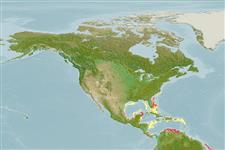Environment: milieu / Zona climática / intervalo de profundidade / distribution range
Ecologia
marinhas demersal; intervalo de profundidade 119 - 156 m (Ref. 12204). Tropical
Western Central Atlantic: off Nicaragua and Venezuela. Records from the Scotian shelf of Canada are based on larval specimens.
Tamanho / Peso / Idade
Maturidade: Lm ? range ? - ? cm
Max length : 11.7 cm SL macho/indeterminado; (Ref. 12204)
Raios dorsais (total) : 91 - 92; Raios anais : 70 - 73. Brown or straw-colored with spots or blotches on the body and fins; usually with a large blotch at the junction of the curved and straight parts of the lateral line and on the lateral line just anterior to the caudal peduncle (Ref. 12204). Head furrows blackish and males with a large black spot on the dorsal fin between the third and seventh rays (Ref. 12204).
Body shape (shape guide): short and / or deep.
Rare species (Ref. 5217).
Ciclo de vida ou comportamento de acasalamento
Maturidade | Reprodução | Desova | Ovos | Fecundidade | Larvas
Coad, B.W., 1995. Encyclopedia of Canadian fishes. Canadian Museum of Nature and Canadian Sportfishing Productions Inc. Singapore. (Ref. 12204)
Status na Lista Vermelha da UICN (Ref. 130435: Version 2025-1)
Ameaça para os humanos
Harmless
Uso pelos humanos
Pescarias: sem interesse
Ferramentas
Relatórios especiais
Baixar XML
Fontes da internet
Estimates based on models
Preferred temperature (Ref.
123201): 17.9 - 23.7, mean 21.6 °C (based on 8 cells).
Índice de diversidade filogenética (Ref.
82804): PD
50 = 0.5625 [Uniqueness, from 0.5 = low to 2.0 = high].
Bayesian length-weight: a=0.00912 (0.00408 - 0.02036), b=3.04 (2.85 - 3.23), in cm total length, based on LWR estimates for this (Sub)family-body shape (Ref.
93245).
Nível Trófico (Ref.
69278): 3.5 ±0.4 se; based on size and trophs of closest relatives
Resiliência (Ref.
120179): médio(a), tempo mínimo de duplicação da população 1,4 - 4,4 anos (Preliminary K or Fecundity.).
Fishing Vulnerability (Ref.
59153): Low vulnerability (10 of 100).
🛈
